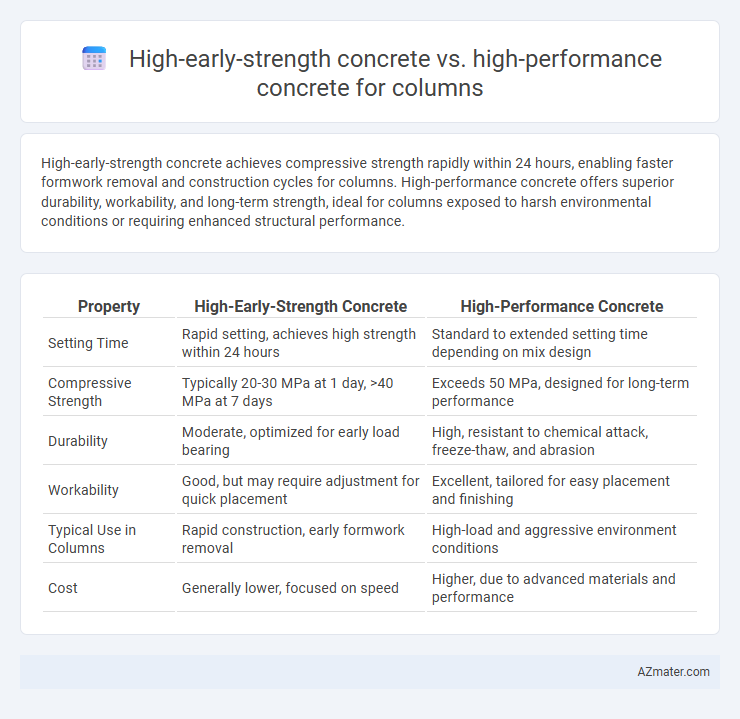High-early-strength concrete achieves compressive strength rapidly within 24 hours, enabling faster formwork removal and construction cycles for columns. High-performance concrete offers superior durability, workability, and long-term strength, ideal for columns exposed to harsh environmental conditions or requiring enhanced structural performance.
Table of Comparison
| Property | High-Early-Strength Concrete | High-Performance Concrete |
|---|---|---|
| Setting Time | Rapid setting, achieves high strength within 24 hours | Standard to extended setting time depending on mix design |
| Compressive Strength | Typically 20-30 MPa at 1 day, >40 MPa at 7 days | Exceeds 50 MPa, designed for long-term performance |
| Durability | Moderate, optimized for early load bearing | High, resistant to chemical attack, freeze-thaw, and abrasion |
| Workability | Good, but may require adjustment for quick placement | Excellent, tailored for easy placement and finishing |
| Typical Use in Columns | Rapid construction, early formwork removal | High-load and aggressive environment conditions |
| Cost | Generally lower, focused on speed | Higher, due to advanced materials and performance |
Introduction to High-Early-Strength and High-Performance Concrete
High-early-strength concrete attains compressive strength rapidly, often reaching over 20 MPa within 24 hours, making it ideal for accelerated construction schedules and early load application in columns. High-performance concrete exhibits superior durability, workability, and long-term strength, designed to meet specific structural demands such as enhanced resistance to environmental deterioration or heavy load-bearing capacity. Selecting between these concretes depends on project requirements involving time constraints, structural performance, and environmental conditions for column applications.
Key Properties of High-Early-Strength Concrete for Columns
High-early-strength concrete for columns offers rapid strength development, achieving up to 70% of its design strength within 24 hours, enabling faster formwork removal and accelerated construction schedules. It typically exhibits high early compressive strength, reduced permeability, and good durability, which are essential for load-bearing structural elements like columns. Compared to high-performance concrete, it prioritizes early-age strength gain over enhanced long-term mechanical properties and durability features.
Essential Characteristics of High-Performance Concrete in Column Applications
High-performance concrete (HPC) in column applications exhibits essential characteristics including superior durability, enhanced mechanical strength, and improved workability compared to high-early-strength concrete. HPC's optimized mix design incorporates supplementary cementitious materials and chemical admixtures, resulting in reduced permeability and increased resistance to environmental aggressors, which is critical for long-term structural integrity. Emphasizing controlled curing and precise quality control ensures HPC achieves its targeted compressive strength typically exceeding 60 MPa, providing robust load-bearing capacity essential for high-rise and infrastructure columns.
Comparative Compressive Strength: High-Early-Strength vs High-Performance Concrete
High-early-strength concrete achieves compressive strengths of 20-30 MPa within the first 24 hours, making it ideal for rapid construction and early formwork removal in columns. High-performance concrete, while often reaching similar or higher ultimate compressive strengths of 40-100 MPa, develops strength more gradually but offers enhanced durability and mechanical properties. The choice between the two depends on project timelines and the required balance between strength development speed and long-term performance.
Durability and Long-Term Performance for Structural Columns
High-early-strength concrete achieves rapid strength gain, enabling faster construction but may exhibit lower long-term durability compared to high-performance concrete, which is engineered for enhanced durability through optimized mix design, improved resistance to environmental stressors, and reduced permeability. High-performance concrete offers superior resistance to chloride ion penetration, sulfate attack, and freeze-thaw cycles, critical for the longevity of structural columns in harsh environments. The use of supplementary cementitious materials and proper curing in high-performance concrete ensures sustained mechanical properties and structural integrity over the column's service life.
Shrinkage, Creep, and Crack Resistance in Columns
High-early-strength concrete exhibits rapid strength gain, which reduces early-age shrinkage and mitigates initial cracking risk in columns, making it suitable for fast-track construction. High-performance concrete offers superior long-term mechanical properties, enhanced creep resistance, and improved crack control due to its optimized mix design and lower water-cement ratio. For columns, high-performance concrete ensures durability and structural integrity under sustained loads, while high-early-strength concrete excels in scenarios demanding quick formwork removal and early load application.
Workability and Placement: Challenges and Considerations
High-early-strength concrete for columns offers rapid setting and early load-bearing capacity but often presents workability challenges due to its lower slump and faster hydration rates, requiring precise timing for placement and compaction. High-performance concrete, engineered for enhanced durability and strength, maintains better workability with chemical admixtures that improve flow and reduce segregation, facilitating easier placement in complex column forms. Both types demand careful mix design and skilled execution to mitigate risk of honeycombing and ensure structural integrity.
Economic Factors: Cost, Time Savings, and Resource Efficiency
High-early-strength concrete reduces formwork time by achieving quick load-bearing capacity, leading to faster construction schedules and lower labor costs, making it cost-effective for column construction. High-performance concrete, while generally more expensive due to advanced materials and mix designs, offers enhanced durability and lifespan, reducing long-term maintenance expenses and resource use. Choosing between the two depends on balancing initial investment against time savings and lifecycle economic benefits in column projects.
Best Use Cases and Project Scenarios for Each Concrete Type
High-early-strength concrete is ideal for projects requiring rapid formwork removal and early load application, such as emergency repairs, fast-track construction, and cold-weather concreting. High-performance concrete offers superior durability and strength, making it suitable for high-rise buildings, heavy-load bearing columns, and infrastructure exposed to aggressive environmental conditions. Selecting the appropriate concrete depends on project timelines, structural demands, and exposure conditions to optimize safety and efficiency.
Conclusion: Selecting the Optimal Concrete for Column Applications
High-early-strength concrete offers rapid strength gain, making it ideal for projects with tight construction schedules or early load requirements in columns. High-performance concrete provides superior durability, enhanced mechanical properties, and resistance to environmental factors, ensuring long-term structural integrity. Selecting the optimal concrete for columns depends on balancing immediate load-bearing needs with longevity demands, where high-early-strength concrete suits accelerated timelines, and high-performance concrete is preferred for critical, durable applications.

Infographic: High-early-strength concrete vs High-performance concrete for Column
 azmater.com
azmater.com